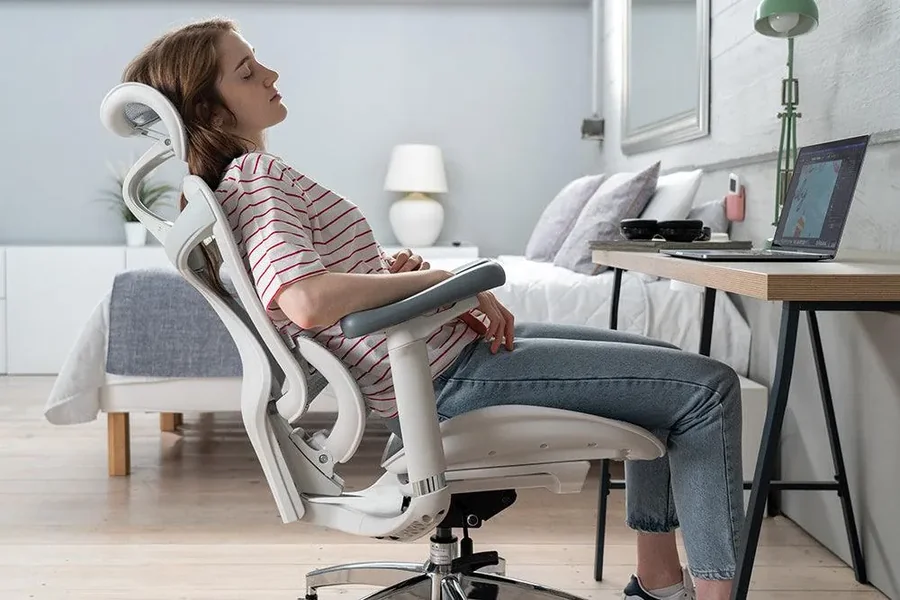The health effects of a computer chair begin where most people forget to look—at the feet. How your feet interact with the floor sets the baseline for everything above. If your feet dangle or sit unevenly, your body starts to compensate, often in unhealthy ways. The pressure concentrates on the thighs, cutting circulation. Over time, this can cause swelling, tingling, or the development of varicose veins.
A chair that’s too high for your legs forces you to tiptoe or lean forward, disrupting alignment. Chairs too low, on the other hand, bend the knees past 90 degrees, creating a similar circulation bottleneck. Feet planted flat on the floor, with knees level to the hips, form the foundation of stable seated posture.
Many chairs assume users are the same height, but that’s rarely true. This makes adjustable seat height essential. Better chairs include footrests or allow for external foot platforms—especially helpful for shorter users. Constant weight distribution and movement at the feet also help activate the calf muscles, which pump blood back toward the heart.
Inadequate foot support can also throw off pelvic tilt. When the pelvis rotates, the spine follows. From there, imbalances ripple upward. Good chairs, therefore, support the entire kinetic chain starting from the floor—not just the backrest.
The Spine’s Silent Scream: What Slouching Really Does
The spine carries your body’s weight through three main curves: lumbar (lower back), thoracic (mid-back), and cervical (neck). A poor chair allows—or even encourages—these natural curves to collapse. When lumbar support is absent or too firm, the pelvis tucks backward. The lumbar curve flattens, the thoracic spine hunches, and the neck pushes forward to maintain eye-level vision.
The result: a cascade of compressive forces on spinal discs. Over time, this leads to degeneration, herniated discs, and worsening scoliosis. These changes don’t happen overnight. Instead, they accumulate over years of static, unsupported sitting.
One major problem is the passive nature of most office chairs. They permit slumping and rounded shoulders. High-quality ergonomic chairs actively support the natural “S” shape of the spine. Adjustable lumbar depth and height allow the user to target support to their body’s structure. A dynamic backrest that tilts and returns—without forcing the user forward—lets the spine move subtly throughout the day.
Backrests that recline slightly (100°–110°) reduce disc pressure in the lumbar region. Fixed upright angles create rigid compression. Armrest position also matters. Without proper elbow support, the shoulders elevate, pulling on neck muscles and contributing to spinal imbalance.
What’s often overlooked is how this affects the cervical spine. Poor spinal posture pulls the neck forward, straining the muscles at the base of the skull and across the upper back. This leads to tension headaches, jaw issues, and nerve impingement.
Sitting upright isn’t about willpower. It’s about external support. A well-designed chair does the work of posture maintenance without constant user awareness. It becomes a passive health device, holding your alignment while you focus on tasks.
Shoulder Tension and Arm Position: The Invisible Weight
Most people don’t realize their shoulders are carrying the load of poor chair and desk setup. A desk too high or a chair too low causes users to lift their arms unnaturally. The trapezius and deltoid muscles remain in a constant state of tension. Over time, this causes tightness, pain, and eventually stiffness or impingement.
Armrests without adjustability add to the issue. If they’re too high, they push the shoulders up. Too low, and they provide no support at all. Ideally, elbows should rest at about 90°–100°, close to the body. This relaxes the shoulders and reduces neck strain.
When this angle is off, users unconsciously hunch or lean to one side. Over time, this asymmetry leads to muscular imbalances and repetitive strain injuries. Rotator cuff issues and frozen shoulder are common in long-term sedentary workers.
A good chair offers adjustable armrests—both vertically and laterally. Some even pivot inward to support forearms during typing. It’s not just about support; it’s about preventing compensation. Each poor angle adds invisible weight that your muscles silently endure until they fail.
Combining ergonomic chair support with proper desk height (generally at elbow level when seated) reduces unnecessary shoulder activation. When arms relax, the upper back stops overcompensating. This relieves pressure not only on muscles, but also on the nerves in the neck and upper spine.
Breathing and Blood Flow: The Posture-Pressure Link
Collapsed posture doesn’t just affect muscles and bones. It also alters how we breathe. A slouched position compresses the diaphragm, reducing its ability to contract fully. This limits lung expansion and decreases oxygen intake. Over time, it creates shallow, chest-based breathing patterns rather than diaphragmatic ones.
Shallow breathing reduces oxygen supply to the brain and other organs. This can lead to fatigue, brain fog, and even increased anxiety. Inadequate oxygen also slows recovery from physical and mental stress.
Posture also impacts circulation. A rounded back restricts chest expansion and narrows blood vessels. The result is lower oxygenated blood flow, particularly to the extremities. Cold hands and feet during sedentary work often indicate this problem.
Proper chair design allows upright posture without forcing it. A slight recline in the backrest, combined with firm lumbar support, opens the ribcage and reduces pressure on the diaphragm. This encourages deeper, more natural breathing rhythms.
Micro-movements—subtle tilts or stretches allowed by dynamic chairs—also stimulate the diaphragm and core muscles. This keeps circulation active, particularly important during extended work sessions. Oxygen uptake improves, which supports better energy, clarity, and overall resilience.
The Mind-Body Feedback Loop: How Chairs Affect Mental State
Physical posture and mental state are tightly linked. Poor posture doesn’t just reflect low mood—it can reinforce it. Slouching decreases alertness, impairs working memory, and contributes to fatigue. Studies in cognitive neuroscience show that upright posture enhances mood and improves performance on attention-based tasks.
The reason is physiological. Posture affects hormone regulation, oxygen delivery, and blood flow to the brain. A collapsed seated position increases cortisol, the stress hormone, and can amplify feelings of anxiety or irritability. Conversely, open and upright postures promote a sense of calm and readiness.
Movement is also key. Chairs that allow small shifts—backward leans, seat tilts, or minor rocking—promote engagement. These micro-movements send sensory feedback to the brain, which can break monotony and refresh focus. Static sitting, even in a well-supported position, leads to mental dullness.
Good ergonomic chairs encourage these shifts without distracting the user. They support movement while maintaining alignment. Features like synchro-tilt mechanisms or seat pans that flex slightly with weight shifts help maintain both comfort and mental clarity.
While no chair solves mental health challenges alone, seating that supports posture and encourages movement contributes directly to cognitive health. In long workdays, this can mean the difference between productivity and burnout.
The Break Myth: Why You Can’t Just Stand Up Every Hour
Many workers rely on the “hourly break” rule to offset bad seating. While movement is vital, it cannot fully undo the physical stress accumulated by sitting in a poorly designed chair. If the chair creates spinal compression, shoulder elevation, or pelvic tilt, these issues build even between breaks.
Research shows that musculoskeletal strain accumulates within the first 20–30 minutes of poor sitting. Even if a person stands up for five minutes every hour, the underlying posture problem persists across the remaining 55 minutes. Think of it like brushing teeth after drinking soda all day—it helps, but it doesn’t reverse the damage.
A good chair reduces the rate at which strain accumulates. This extends the window between needed breaks and reduces the intensity of postural stress. When you do take a break, it complements—not compensates for—the chair’s support.
By contrast, bad chairs accelerate deterioration. Muscles tire quickly, blood flow slows, and discomfort builds fast. Standing up becomes a way to escape pain, not a proactive health practice.
Breaks matter, but they work best when combined with dynamic seating. Chairs that allow motion while seated offer continuous relief, even when you’re not standing. Over an eight-hour day, this cumulative effect is substantial.
Investing in quality seating isn’t about avoiding breaks—it’s about making every seated moment less harmful and more productive.
Your Chair as Health Equipment, Not Office Decor
Chairs are often viewed as furniture—an aesthetic choice based on color, style, or price. But for anyone spending hours at a desk, a computer chair is health equipment. The difference between a $100 decorative chair and a $600 ergonomic one isn’t luxury—it’s long-term spinal health.
Workplace injuries caused by prolonged sitting are among the most common occupational health issues. These include carpal tunnel syndrome, chronic back pain, and circulatory disorders. Many of these injuries stem not from overuse, but from poor passive design.
Just as athletes invest in good shoes or runners wear supportive gear, desk workers need tools suited to their activity. A good chair reduces pain, boosts energy, and sustains focus—three drivers of real productivity. It’s not about pampering; it’s about function.
Culturally, we often treat chair quality as optional. Companies spend more on software licenses than on seating. Meanwhile, employees slump in chairs designed for occasional guests. In hospitality, for example, restaurant furniture is built for short stays—not for continuous support. Applying that model to office seating is a mistake.
Shifting perspective from “furniture” to “health equipment” reframes the decision. It invites prioritization based on outcome—reduced injury, improved efficiency, lower absenteeism—not just aesthetics. For freelancers, remote workers, and students, the same logic applies. Your chair either supports your body or sabotages it.
Even budget options can offer better design if chosen wisely. Focus on features, not price tags: adjustability, lumbar support, quality materials, and dynamic movement matter more than brand or appearance. In the long run, what you sit on may influence your health more than what you sleep on.






